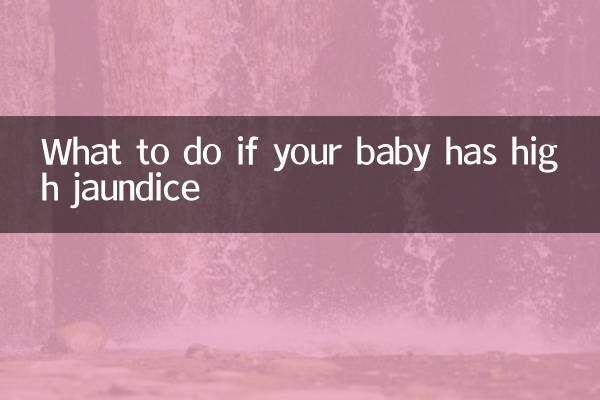What should I do if my baby has high jaundice? A must-read guide for new parents
Neonatal jaundice is a common physiological phenomenon, but if the jaundice value is high or lasts too long, it may cause parents to worry. This article combines hot topics and medical advice on the Internet in the past 10 days to provide you with structured solutions.
1. Basic knowledge of jaundice

| Type | Features | Appearance time | duration |
|---|---|---|---|
| physiological jaundice | Yellowing of skin/whites of eyes | 2-3 days old | ≤2 weeks (term infant) |
| pathological jaundice | Rapid progress, severe degree | Within 24 hours of birth | >2 weeks or recurring |
| breast milk jaundice | Mild and persistent | 1 week after birth | Up to 3-12 weeks |
2. Comparison table of jaundice risk levels
| Age in days | Low risk value (mg/dL) | Intermediate risk value (mg/dL) | High risk value (mg/dL) |
|---|---|---|---|
| ≤24h | <6 | 6-8 | >8 |
| 25-48h | <9 | 9-12 | >12 |
| 49-72h | <12 | 12-15 | >15 |
| >72h | <15 | 15-18 | >18 |
3. Step-by-step guide for response measures
Step one: preliminary judgment
• Observation range: From the face → chest → abdomen → limbs, please be wary of progressive yellowing.
• Recording time: Take photos under the same light environment every day for comparison
• Accompanying symptoms: Milk refusal, drowsiness, and screaming require immediate medical attention
Step Two: Home Care
| method | Operational points | Things to note |
|---|---|---|
| sunlight exposure | Before 10:00/after 15:00, 15 minutes each time | Avoid direct exposure to eyes, windows are ineffective |
| Increase feeding | 8-12 times a day, total amount ≥150ml/kg | If breast milk is insufficient, formula milk can be temporarily added |
| probiotic aid | Select the BB-12/LGG strain | Need to be taken under the guidance of a doctor |
Step Three: Medical Intervention
•Indications for phototherapy: Exceeds the high-risk value for this age or rises >5mg/dL every day
•Exchange transfusion standards: Total bilirubin ≥25mg/dL or neurological symptoms
•Breastfeeding pause: Only for confirmed breast milk jaundice, suspend feeding for 3 days and then resume feeding
4. Answers to recent hotly discussed questions
Q1: Is it necessary to delay vaccination for jaundice vaccine?
According to the latest "Consensus on the Management of Neonatal Jaundice", simple physiological jaundice does not affect vaccination, while pathological jaundice requires revaccination after the bilirubin is <15mg/dL.
Q2: Is the home jaundice detector reliable?
The error range of transcutaneous jaundice meter (such as JM-103 type) is about ±3mg/dL, which is only suitable for trend monitoring. Serum testing is required for confirmed diagnosis.
5. Emergency medical treatment signal
| Symptoms | possible consequences | response time |
|---|---|---|
| Yellowing of palms of limbs | Bilirubin encephalopathy risk | Within 2 hours |
| Grayish white stool | Possible biliary atresia | Within 24 hours |
| Fever/convulsions | manifestations of acute infection | See a doctor immediately |
6. Things to note during the recovery period
• Follow-up testing: Bilirubin recheck on 3/7/14 days after discharge
• Nutritional support: Those who insist on breastfeeding should supplement with 400IU vitamin D daily.
• Developmental monitoring: Assess motor development when corrected for age in months
Special reminder: The data in this article come from the National Health Commission's "Standards for the Diagnosis and Treatment of Neonatal Jaundice" (2023 Edition) and the Clinical Guidelines of the Pediatric Branch of the Chinese Medical Association. Please follow your doctor's advice for specific diagnosis and treatment.

check the details

check the details